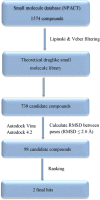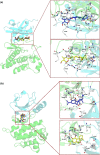Identification of Phytochemicals Targeting c-Met Kinase Domain using Consensus Docking and Molecular Dynamics Simulation Studies
- PMID: 28852971
- PMCID: PMC7090793
- DOI: 10.1007/s12013-017-0821-6
Identification of Phytochemicals Targeting c-Met Kinase Domain using Consensus Docking and Molecular Dynamics Simulation Studies
Abstract
c-Met receptor tyrosine kinase is a proto-oncogene whose aberrant activation is attributed to a lower rate of survival in most cancers. Natural product-derived inhibitors known as "fourth generation inhibitors" constitute more than 60% of anticancer drugs. Furthermore, consensus docking approach has recently been introduced to augment docking accuracy and reduce false positives during a virtual screening. In order to obtain novel small-molecule Met inhibitors, consensus docking approach was performed using Autodock Vina and Autodock 4.2 to virtual screen Naturally Occurring Plant-based Anti-cancer Compound-Activity-Target database against active and inactive conformation of c-Met kinase domain structure. Two hit molecules that were in line with drug-likeness criteria, desired docking score, and binding pose were subjected to molecular dynamics simulations to elucidate intermolecular contacts in protein-ligand complexes. Analysis of molecular dynamics simulations and molecular mechanics Poisson-Boltzmann surface area studies showed that ZINC08234189 is a plausible inhibitor for the active state of c-Met, whereas ZINC03871891 may be more effective toward active c-Met kinase domain compared to the inactive form due to higher binding energy. Our analysis showed that both the hit molecules formed hydrogen bonds with key residues of the hinge region (P1158, M1160) in the active form, which is a hallmark of kinase domain inhibitors. Considering the pivotal role of HGF/c-Met signaling in carcinogenesis, our results propose ZINC08234189 and ZINC03871891 as the therapeutic options to surmount Met-dependent cancers.
Keywords: Binding free energy; Consensus docking; Molecular dynamics simulation; Natural products; c-Met inhibitor.
Conflict of interest statement
The authors declare that they have no competing interests.
Figures







Similar articles
-
Identification of potential PKC inhibitors through pharmacophore designing, 3D-QSAR and molecular dynamics simulations targeting Alzheimer's disease.J Biomol Struct Dyn. 2018 Nov;36(15):4029-4044. doi: 10.1080/07391102.2017.1406824. Epub 2017 Dec 13. J Biomol Struct Dyn. 2018. PMID: 29182053
-
3D-QSAR-aided design of potent c-Met inhibitors using molecular dynamics simulation and binding free energy calculation.J Biomol Struct Dyn. 2019 May;37(8):2165-2178. doi: 10.1080/07391102.2018.1479309. Epub 2018 Nov 1. J Biomol Struct Dyn. 2019. PMID: 30044205
-
Studying the Binding Modes of Novel 2-Aminopyridine Derivatives as Effective and Selective c-Met Kinase Type 1 Inhibitors Using Molecular Modeling Approaches.Molecules. 2020 Dec 24;26(1):52. doi: 10.3390/molecules26010052. Molecules. 2020. PMID: 33374386 Free PMC article.
-
Recent Progress in the Development of Small Molecule c-Met Inhibitors.Curr Top Med Chem. 2019;19(15):1276-1288. doi: 10.2174/1568026619666190712205353. Curr Top Med Chem. 2019. PMID: 31526339 Review.
-
Recent advances in the development of dual VEGFR and c-Met small molecule inhibitors as anticancer drugs.Eur J Med Chem. 2016 Jan 27;108:495-504. doi: 10.1016/j.ejmech.2015.12.016. Epub 2015 Dec 13. Eur J Med Chem. 2016. PMID: 26717201 Review.
Cited by
-
Natural products as inhibitors against pancreatic cancer cell proliferation and invasion: possible mechanisms.Am J Cancer Res. 2024 Jun 15;14(6):2695-2713. doi: 10.62347/XLZX8935. eCollection 2024. Am J Cancer Res. 2024. PMID: 39005683 Free PMC article. Review.
-
Curcumin inhibits spike protein of new SARS-CoV-2 variant of concern (VOC) Omicron, an in silico study.Comput Biol Med. 2022 Jul;146:105552. doi: 10.1016/j.compbiomed.2022.105552. Epub 2022 Apr 27. Comput Biol Med. 2022. PMID: 35508082 Free PMC article.
-
Evaluation of tea (Camellia sinensis L.) phytochemicals as multi-disease modulators, a multidimensional in silico strategy with the combinations of network pharmacology, pharmacophore analysis, statistics and molecular docking.Mol Divers. 2023 Feb;27(1):487-509. doi: 10.1007/s11030-022-10437-1. Epub 2022 May 10. Mol Divers. 2023. PMID: 35536529 Free PMC article.
-
Key Topics in Molecular Docking for Drug Design.Int J Mol Sci. 2019 Sep 15;20(18):4574. doi: 10.3390/ijms20184574. Int J Mol Sci. 2019. PMID: 31540192 Free PMC article. Review.
-
MicroRNA‑200a suppresses migration and invasion and enhances the radiosensitivity of NSCLC cells by inhibiting the HGF/c‑Met signaling pathway.Oncol Rep. 2019 Mar;41(3):1497-1508. doi: 10.3892/or.2018.6925. Epub 2018 Dec 12. Oncol Rep. 2019. PMID: 30569179 Free PMC article.
References
MeSH terms
Substances
Grants and funding
LinkOut - more resources
Full Text Sources
Other Literature Sources
Miscellaneous

